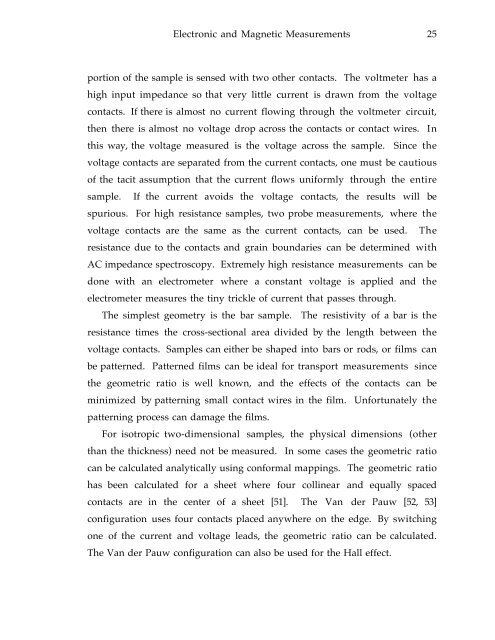MAGNETISM ELECTRON TRANSPORT MAGNETORESISTIVE LANTHANUM CALCIUM MANGANITE
MAGNETISM ELECTRON TRANSPORT MAGNETORESISTIVE LANTHANUM CALCIUM MANGANITE
MAGNETISM ELECTRON TRANSPORT MAGNETORESISTIVE LANTHANUM CALCIUM MANGANITE
Create successful ePaper yourself
Turn your PDF publications into a flip-book with our unique Google optimized e-Paper software.
Electronic and Magnetic Measurements 25<br />
portion of the sample is sensed with two other contacts. The voltmeter has a<br />
high input impedance so that very little current is drawn from the voltage<br />
contacts. If there is almost no current flowing through the voltmeter circuit,<br />
then there is almost no voltage drop across the contacts or contact wires. In<br />
this way, the voltage measured is the voltage across the sample. Since the<br />
voltage contacts are separated from the current contacts, one must be cautious<br />
of the tacit assumption that the current flows uniformly through the entire<br />
sample. If the current avoids the voltage contacts, the results will be<br />
spurious. For high resistance samples, two probe measurements, where the<br />
voltage contacts are the same as the current contacts, can be used. The<br />
resistance due to the contacts and grain boundaries can be determined with<br />
AC impedance spectroscopy. Extremely high resistance measurements can be<br />
done with an electrometer where a constant voltage is applied and the<br />
electrometer measures the tiny trickle of current that passes through.<br />
The simplest geometry is the bar sample. The resistivity of a bar is the<br />
resistance times the cross-sectional area divided by the length between the<br />
voltage contacts. Samples can either be shaped into bars or rods, or films can<br />
be patterned. Patterned films can be ideal for transport measurements since<br />
the geometric ratio is well known, and the effects of the contacts can be<br />
minimized by patterning small contact wires in the film. Unfortunately the<br />
patterning process can damage the films.<br />
For isotropic two-dimensional samples, the physical dimensions (other<br />
than the thickness) need not be measured. In some cases the geometric ratio<br />
can be calculated analytically using conformal mappings. The geometric ratio<br />
has been calculated for a sheet where four collinear and equally spaced<br />
contacts are in the center of a sheet [51]. The Van der Pauw [52, 53]<br />
configuration uses four contacts placed anywhere on the edge. By switching<br />
one of the current and voltage leads, the geometric ratio can be calculated.<br />
The Van der Pauw configuration can also be used for the Hall effect.
















